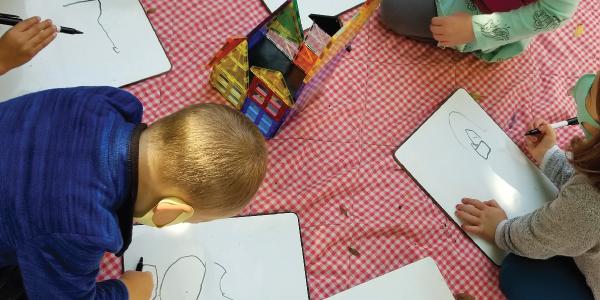Equitable, Effective Early Childhood Education for All: Policy and Advocacy to Get Us There

You are here
Lately, I have been spending time in the archives of Young Children. Turning back the clock in this way has reminded me both of how far we as a field have come (there is now public kindergarten in most states and public pre-K in some) and how advocating for equitable, effective early childhood education for all children continues to be essential around important issues (educator pay; quality programs that offer joyful, equitable learning for all). Even back to our first issue in 1945 (published as the Bulletin of the National Association for Nursery Education), pages were filled with information about policy and advocacy to “bring about equal and improved educational opportunity to all children of all ages” and to “make provisions” in line with K–12 education.
In the decades that have passed, we have learned much about what it takes to have “equal and improved educational opportunity for all children of all ages.” We have seen the benefits when early childhood education has the “provisions” found elsewhere in education (public kindergarten). We have also seen some of the disadvantages (assessments and curricula that do not account for playful learning).
Research shows that effective, equitable early childhood education means a confluence of well-compensated, fully supported educators who are knowledgeable and skilled in practices for all children. To achieve this, change is needed at multiple levels. It is needed to fulfill the “audacious vision” outlined in the Unifying Framework for the Early Childhood Education Profession.
For those working daily in early education, being part of that “audacious vision” can feel daunting or out of reach: change can take a long time, it can be confusing where and how to start, and it can be exhausting while juggling so many other responsibilities. But the benefits are wide-reaching: systemic, sustained change will not only be felt by children, families, and educators but also by workplaces and the broader society.
Change and the “audacious vision” are the underlying threads in this issue of Young Children. This cluster begins with Michelle Kang, NAEYC’s chief executive officer. In a special Making Connections column, she underscores the present realities of early childhood educators and programs, asserting that “Substantial, Sustainable, and Comprehensive Investment Is Needed to Move Us Forward.”
Following this are articles that showcase what can be done at different levels to advocate and bring about change. To begin, Eric Bucher, Kamaie Clark, and Kelly Ann Larkin illustrate “The Power in Our Collective Voices: Building Your Skills as an Early Childhood Advocate.” Knowing how essential educators’ voices and experiences are in advocacy, the authors lift the voices and perspectives of early childhood educators who have cultivated their advocacy skills. They also offer five practical ways that readers can do the same.
In addition, we need multiple, equitable pathways to becoming an early childhood professional. Stephanie Irvine, M. Christine Dwyer, Heather Lucas, and Candace O. Vinson describe in “Designing for Demand and Diversity: How One State Is Growing the Early Childhood Workforce in High School” the coordinated, state-level effort to revamp the high school career and technical education career pathway in Michigan. In doing so, they hope others will examine and support this pathway in their own states.
In “Implementing an ‘Audacious Vision’: A Collaborative Approach Across Vermont Higher Education Programs,” Kaitlin Northey and Susan Titterton provide an in-depth look at how their state’s higher education institutions came together to understand and work toward alignment with the Unifying Framework. This journey has depended on honest, sustained conversations among committed stakeholders who remain focused on having efficient, equitable preparation pathways.
To close, Marica Cox Mitchell’s Viewpoint article, “Mind the Mindsets: A Case for More Coherent and Relevant Narratives from the Field,” names and describes outdated mindsets that pervade thinking and policymaking about child care and early learning. Instead, she proposes specific mindset shifts to center and be responsive to families, educators, and administrators and to help us all work toward system change.
Accompanying this Viewpoint is a piece written by Marica Cox Mitchell and Lauren Hogan, managing director of policy and professional advancement at NAEYC. They first shared “Flipping the Script: Educators Driving Public Policy” in the September 2019 issue of Young Children. They return to this piece because significant progress is still needed and major challenges lay ahead. In addition to updating us on victories that are in reach, they give practical ideas for policymakers and educators to close the gap between policy and practice.
It is dependent on all of us to advocate for the “audacious vision” put forth by the Unifying Framework—but early childhood educators, children, and families should be central in any federal, state, or local policy and advocacy initiative. That is the only way to truly elevate the profession and attain the best possible outcomes for each and every child. We invite you to read this issue and join in.
Reflection Questions for This Issue
Early childhood educators can collectively advocate for equitable public policies and funding that support children and families now and for future generations. As you read this issue, ask yourself
- What is one way I can challenge myself to advocate for the children and families in my program and community?
- Am I helping to empower families in my learning setting to advocate for their children? What supports and resources can I offer them?
- This issue also offers strategies for incorporating language development into science activities. Are there strategies you can adopt and adapt right now to enhance children’s language learning during science explorations?
Four-year-olds in this classroom worked cooperatively to build a structure with magnetic tiles, then drew what they saw. Keyed to the book The Most Magnificent Thing, by Ashley Spires, this STEAM investigation offered lessons in perspective: children saw and drew different things depending on their position. (Photograph courtesy of Andrea Diuguid)
Is your classroom full of children’s artwork? To feature it in Young Children, visit https://www.naeyc.org/resources/pubs/authors-photographers/photos or email [email protected] for details.
 We’d love to hear from you!
We’d love to hear from you!
Send your thoughts on this issue, and on topics you’d like to read about in future issues of Young Children, to [email protected].
Copyright © 2023 by the National Association for the Education of Young Children. See Permissions and Reprints online at NAEYC.org/resources/permissions.
Annie Moses, PhD, is director of periodicals at NAEYC and serves as editor in chief of Young Children and Teaching Young Children.
